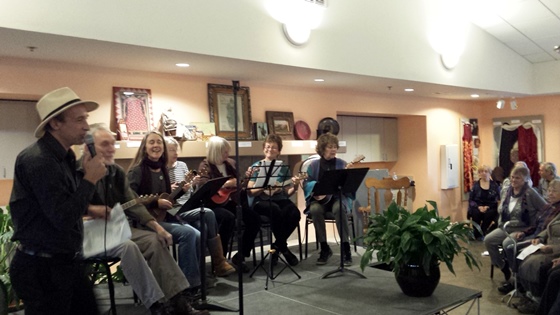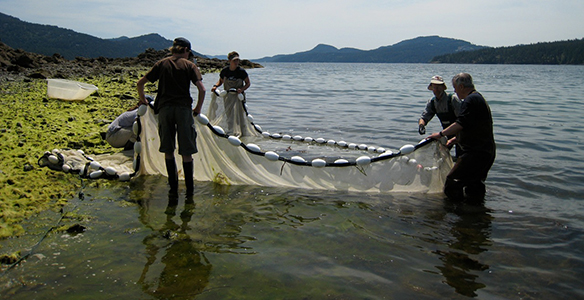||| FROM NPR |||
Amy Cordalis stood in the dawn chill to witness the first big surge as the gate was widened. She’s an attorney and Yurok Tribe member who has played a critical role in advocating for dam removal. As water poured through the tunnel, she could hear boulders rolling and tumbling. The water turned to dark chocolate milk as decades of pent-up sediment surged through.
“This is historic and life-changing,” Cordalis said. “And it means that the Yurok people have a future. It means the river has a future; the salmon have a future.”

Amy Cordalis (left) and Barry McCovey, members of the Yurok Tribe, have played key roles in advocating for the removal of the Klamath River dams.
“It’s kind of surreal,” said Belchik, who has worked on Klamath River water issues for the tribe for nearly 30 years. “I don’t know why we had such confidence that it was going to happen. But we did. We always knew it would happen.”
One hundred seventy-three feet high, with a 740-foot crest, Iron Gate is an earth embankment dam with a skinny, many-fingered reservoir behind it. The lowering — or drawdown — of Iron Gate and two other reservoirs on the Klamath River will make way for the removal of three remaining hydroelectric dams that are part of the Lower Klamath Project in Northern California and southern Oregon.
For decades, these barriers have blocked salmon, steelhead and Pacific lamprey from accessing habitat above them and contributed to poor water quality below. The Klamath River was once the third-largest salmon producer on the West Coast, but in the time since the dams were constructed, the Klamath’s coho and Chinook runs have dwindled to a fraction of their historic abundance.
When tribal activists first started calling for the removal of four Klamath River dams in the late 1990s, people thought they were “crazy,” said Leaf Hillman, an elder of the Karuk Tribe who helped launch the campaign. “We’ve never really considered any other alternative to removing dams. And so it was a fight that we were committed to, and that we knew that we had to win. And it’s been an intergenerational struggle.”
A massive die-off of Chinook salmon in 2002 catalyzed increased activism around getting the dams removed. An estimated 34,000 to 78,000 fish died. The loss of these fish didn’t just mean the loss of a fun summer fishing activity, said Brook Thompson, a Yurok Tribe member who was 7 years old at the time and is now in her late 20s. “Those salmon to me are the connections I have with my relatives,” she explained. “In a day, that was all gone.”

Copco 1, located on the Klamath River in Northern California, is one of three remaining dams in the Lower Klamath Project that will be deconstructed later this year.
“Yurok spirituality and Yurok ways of life cannot exist without having the salmon here,” she said.
While activists celebrate the rebirth of a river, the massive project brings uncertainty to others, particularly residents who live near the dams. In the small town of Copco Lake, Calif., losing their namesake lake means losing the centerpiece of their community. It also brings heightened concerns about how the reshaped landscape will affect their property values and their ability to safeguard their homes from wildfires in a high-risk region.
Up until now, vehicles could easily access the lakeshore to pump water to fight fires, and aircraft could dip their buckets into the lake, according to Francis Gill, a Copco Lake resident and fire chief for the community’s volunteer fire department. Gill fears that the community will be much more exposed to fire without the lake as a buffer.
“Now, instead of having that lake as a huge barrier, we get the potential for fire to jump the river, get from one side to the other easily,” Gill said. “Especially just with the way the wildfires have been getting the last 10 years. They just blow up so fast and get so big, so quickly.”
Other large dam removals on the Penobscot River in Maine and on the Elwha River in Washington state have shown that rivers — and the fish that depend on them — can recover quickly. The successful campaign and restoration of the Klamath watershed will no doubt inform other dam removal efforts.








The Penobscot River in Maine is beautiful. I stood by the banks , a few years ago, and let my mind imagine my grandmother and great aunts and uncles as they played by the river. I had grown up with stories about their childhood playground, but there I was, 70 years old and standing where they stood. I’m happy to read this story. Thank you.